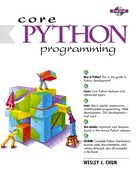6.16. Tuple Operators and Built-in Functions
6.16.1. Standard and Sequence TypeOperators and Built-in Functions
Object and sequence operators and built-in functions act the exact same way toward tuples as they do with lists. You can still take slices of tuples, concatenate and make multiple copies of tuples, validate membership, and compare tuples:
Creation, Repetition, Concatenation
>>> t = (['xyz', 123], 23, -103.4)
>>> t
(['xyz', 123], 23, -103.4)
>>> t * 2
(['xyz', 123], 23, -103.4, ['xyz', 123], 23, -103.4)
>>> t = t + ('free', 'easy')
>>> t
(['xyz', 123], 23, -103.4, 'free', 'easy')
Membership, Slicing
>>> 23 in t 1 >>> 123 in t 0 >>> t[0][1] 123 >>> t[1:] (23, -103.4, 'free', 'easy')
Built-in Functions
>>> str(t) (['xyz', 123], 23, -103.4, 'free', 'easy') >>> len(t) 5 >>> max(t) 'free' >>> min(t) -103.4 >>> cmp(t, (['xyz', 123], 23, -103.4, 'free', 'easy')) 0 >>> list(t) [['xyz', 123], 23, -103.4, 'free', 'easy']
Operators
>>> (4, 2) < (3, 5) 0 >>> (2, 4) < (3, -1) 1 >>> (2, 4) == (3, -1) 0 >>> (2, 4) == (2, 4) 1
6.16.2. Tuple Type Operators and Built-in Functions and Methods
Like lists, tuples have no operators or built-in functions for themselves. All of the list methods described in the previous section were related to a list object's mutability, i.e., sorting, replacing, appending, etc. Since tuples are immutable, those methods are rendered superfluous, thus unimplemented.
..................Content has been hidden....................
You can't read the all page of ebook, please click here login for view all page.
